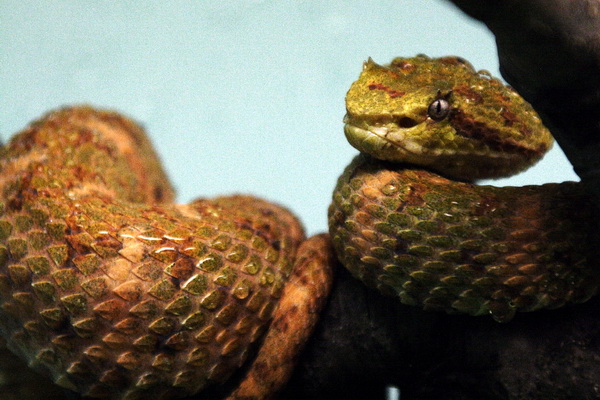| New Photos | Animal News | Animal Sounds | Animal Movies | Upload Photo | Copyright | Korean |
|---|
| Funny Animal Photos | Monsters in Animalia | Wiki Articles Fun Facts about Animals | Links | Home | Mobile A.P.A. |
|---|
| Image Info | Original File Name: Eyelash_palm-pitviper-Eyelash Mountain Viper (Bothriechis schlegelii).jpg Resolution: 600x400 File Size: 107798 Bytes Date: 2006:02:28 09:38:00 Camera: Canon EOS 20D (Canon) F number: f/6.3 Exposure: 1/125 sec Focal Length: 300/1 Upload Time: 2007:09:20 18:51:48 | |
| Author | Name (E-mail): Unknown | |
| Subject | Eyelash Viper (Bothriechis schlegelii) - Wiki | |
 |
| Email : E-Card | Poster | Web Master Delete Edit Info Admin |
| Description | Eyelash Viper (Bothriechis schlegelii) - Wiki
Bothriechis schlegelii
Bothriechis schlegelii is a venomous pit viper species found in Central and South America. No subspecies are currently recognized. Description This is a relatively small species that rarely exceed 75 cm in length, with females being larger than males. They have a wide, triangular-shaped head, and eyes with vertical pupils. Like all pit vipers, they are solenoglyphous, having large, hypodermic needle-like fangs in the upper jaw that fold back when not in use, and have heat sensitive organs, or pits, located on either side of the head between the eye and nostril. Its most distinguishing feature, and origin of its common name, is the set of modified scales over the eyes that look much like eyelashes. The eyelashes are thought to aid in camouflage, breaking up the snake's outline among the foliage it usually hides in. B. schlegelii occurs in a wide range of colors, including red, yellow, brown, green, even pink, as well as various combinations therof. They often have black or brown speckling on the base color. Common names Eyelash viper, eyelash mountain viper, Schlegel's viper, Schlegel's palm viper, eyelash snake, horned palm viper. eyelash pit viper, Schlegel's pit viper. Also known as Bocarac?? in Costa Rica and other Latin American countries. Geographic range Its range extends from southern Mexico (northern Chiapas), southeastward on the Atlantic slope and lowlands through Central America to northern South America in Colombia and Venezuela. Also found on the Pacific versant and lowlands in parts of Costa Rica, Panama, Colombia, Ecuador and Peru. Occurs in mesic forest at elevations almost from sea level to 2640 m altitude. The type locality is "Popayan" (Popay??n, Colombia). Habitat Prefers lower altitude, humid, tropical areas with dense foliage, generally not far from a permanent water source. Behavior Like other Bothriechis members, this species is arboreal, having a strongly prehensile tail. It is largely nocturnal, consuming small rodents, frogs, lizards, and small birds. They are not known to be an aggressive snake, but will not hesitate to strike if harassed. A typical ambush predator, it waits patiently for unsuspecting prey to wander by. Sometimes, it is known to select a specific ambush site and return to it every year in time for the spring migration of birds. Studies have indicated that these snakes learn to improve their strike accuracy over time. Sometimes these snakes (especially juveniles) will employ what is known as "caudal luring", where they will wiggle their tail in worm-like motions to encourage potential prey to move within striking range. Reproduction Eyelash vipers are ovoviviparous, giving birth to an average of 10-12 young on a yearly basis, that are 6-8 inches in length. Captivity Despite the inherent danger of its venom, B. schlegelii is frequently available in the exotic animal trade, and is well represented in zoos worldwide. It is frequently captive bred for color and pattern. Exporting from the wild is not as common as it once was, but is not unknown. In general they make hardy captives, readily feeding on provided mice. As they make impressive display specimens, particularly desirable colorations can command high prices. Taxonomy Some authorities also recognize a montane form that is treated either as a subspecies (B. s. supraciliaris) or as a species (B. supraciliaris). It has been commonly referred to as the eyelash mountain viper and is only found in the province of San Jos?? in Costa Rica. http://en.wikipedia.org/wiki/Bothriechis_schlegelii
| |||
| Comments |
| ||||||||||||||||||||||||||||||||||||||||||||||||||||||||||
| Copyright Info | AnimmalPicturesArchive.com does not have the copyright for this image. This photograph or artwork is copyright by the photographer or the original artist. If you are to use this photograph, please contact the copyright owner or the poster. |
|
|
|
| |||||||
| CopyLeft © since 1995, Animal Pictures Archive. All rights may be reserved. | ||||||||
Stats